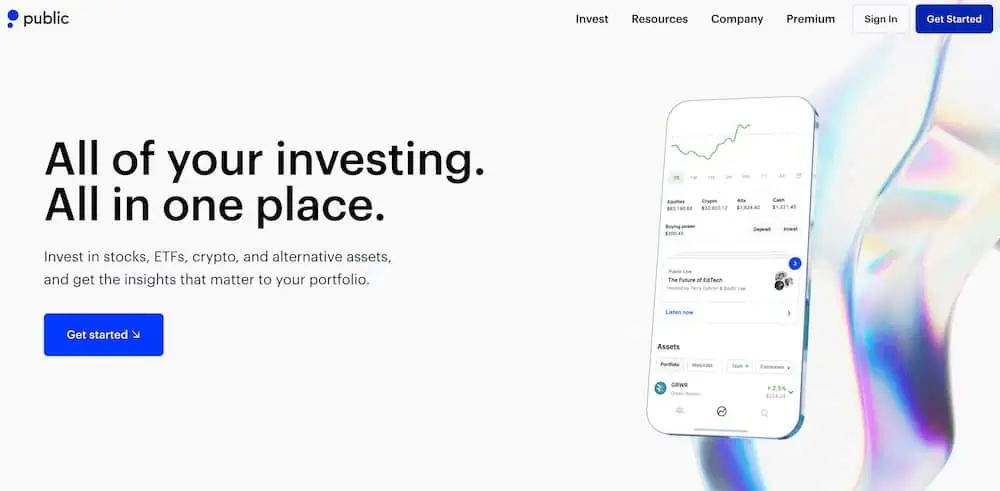If you’re looking for ways to bolster your portfolio with passive income, a lesser-known, infrequently explored corner of the investment world—credit markets—might be right for you.
The term “credit market” refers to the space where the government, companies, and individuals can raise money by issuing debt to investors. The capital structure varies for different types of credit investments, but, in general, when you invest in debt instruments, you’re effectively putting money to work in exchange for your money back, plus interest, later.
And naturally, depending on which type of credit investment you make, the risk, potential payout, and overall capital structure can vary significantly.
Credit investing can be an excellent way to diversify your investments and earn a passive income. But first, you need to understand the process and which investments make the most sense for you. And that’s what I’ll try to help you do today.
Read on as I explain how credit investing works, discuss various types of public and private debt investments, and go over how individuals can find these opportunities. If you currently only own stock, hopefully by the end, you’ll appreciate the virtues of diversifying into both equity and debt investments.
What Is Credit Investing?
Credit investing is an investment in debt securities—bonds are the most popular debt investments, but they can also include securitized obligations, collateralized debt obligations, mortgage-backed securities, and more.
How Does Credit Investing Work?
Credit investing involves an investor lending money to an issuer, such as a company or governmental entity (like a city, state, even the federal government). In exchange for the upfront capital, the entity repays the loan with interest. The interest usually is paid periodically over the predetermined loan term, and the face value is paid at maturity.
The annual interest rate on the bond (referred to as the “coupon” and expressed as a percentage of the bond’s face value) differs from one bond to the next. Interest rates are typically determined by a benchmark interest rate (such as the Federal Reserve’s fed funds rate). Also, the longer the repayment term, the higher the interest rate you’ll typically receive.
Risk also affects interest rates. Credit rating agencies evaluate companies and assign credit ratings to show investors the likelihood of a business defaulting on its bonds. Investment-grade bonds are more likely than non-investment-grade bonds to make timely payments. But the latter typically pays more interest.
Credit investments are different than when you invest in stocks (equity). With equity investments, your return largely depends on how well or poorly the company performs. But with bonds and many other debt securities, your returns aren’t dependent on how the issuer is performing financially—to an extent. (If a business’s financials deteriorate enough, they might not be able to repay their debts.)
One major variable to consider when evaluating any debt investment is the nature of its interest payments. Credit investments can be broken down into a few interest categories:
Fixed-Rate Securities
Fixed-rate debt securities use the same coupon rate for the whole life of the investment. Also known as fixed-income securities, this is the most common structure for a debt investment.
Floating-Rate Securities
Floating-rate debt securities use rates that are based on a benchmark interest rate and change as the benchmark does. The upside? If, say, the Federal Reserve raises its benchmark rate to fight inflation, these securities will pay more, helping to offset the effects of inflation. The flip side? If interest rates fall, these floating-rate securities might pay lower rates, too.
Zero-Coupon Securities
Zero-coupon debt securities don’t pay interest. Instead, you buy the bond for less than its face value, and when it matures, you are paid the face amount. For example: A 20-year zero-coupon bond with a face value of $10,000 might sell for $3,500, then in 20 years, you could cash that bond in for $10,000.
Types of Publicly Traded Debt Investments
Investors on the public markets have access to all sorts of different debt investments, mostly tied to either governments or corporations. Here are the most prominent types of publicly traded debt:
1. Federal Government Bonds
Aside from raising money for projects, governments issue debt for day-to-day operations and even to refinance other debts. Federal debt comes packaged for investors in several different forms.
Treasuries (Treasury Marketable Securities)
- T-bills: Short-term securities with five term options ranging from four weeks to 52 weeks. These are sold at face value, or discounted, and once matured you’re paid the face value.
- T-notes: Government securities with maturities of two, three, five, seven, or 10 years. These pay interest every six months until they mature.
- T-bonds: Treasury bonds have maturities of 20 years or 30 years. You receive interest payments every six months.
- Treasury Inflation-Protected Securities (TIPS): The principal for these securities is adjusted according to the consumer price index. Terms are for five, 10, or 30 years, and interest is paid every six months.
- Floating-Rate Notes (FRNs): These are short-term investments with “floating” (variable) rates that mature in two years and pay interest four times a year.
Agency bonds
Agency bonds are issued by a federal agency or a government-sponsored enterprise. These are usually issued by broker-dealers and are highly liquid as they are actively traded (though less liquid than Treasury bonds). They provide higher returns than Treasuries, but they don’t account for inflation.
Savings bonds
To be clear: Savings bonds are not tradeable. While they’re available to just about anyone, they’re not found on the credit markets, per se. Instead, you merely buy these on TreasuryDirect.gov and hold them until you’re ready to redeem them.
- EE bonds: Series EE savings bonds earn fixed interest rates for 30 years, and they offer a return of double the value initially purchased if held for at least 20 years.
- I bonds: Series I savings bonds have both a fixed interest rate, as well as an inflation-adjusted interest rate that’s calculated twice each year. The reason? Series I savings bonds are designed to protect your savings from inflation (rising prices).
2. Municipal Bonds
Municipal bonds, nicknamed “munis,” are debt securities issued by state, county, or local governments. The funds are commonly used to pay for public projects, such as building schools. In exchange for the upfront capital, bondholders receive (usually semi-annual) interest payments as well as their principal balance back upon maturity.
These investments are exempt from federal taxes and often from state and local taxes, as well, if you live in the issuing state. Typically, the interest rate is lower than that of corporate bonds, but their tax benefits can even that out. Thus, these are one of the best investments for taxable accounts.
There are short-term munis that range from one to three years and long-term bonds that can take more than a decade to mature.
3. Corporate Bonds
Corporate bonds are debt investments issued by a firm to raise money for expansions, new equipment, and much more. Investors who buy corporate bonds receive interest on their principal amount and usually get the principal back once the bond matures.
Unlike an equity investment, corporate bonds don’t give you any ownership in the company. And again, their performance is not strongly tied to the company’s operational results.
4. Commercial Paper
Commercial paper is another type of debt investment issued by corporations. Commercial paper is usually used to finance short-term liabilities, such as payroll.
Why would a company use commercial paper? It’s easier for corporations to handle commercial paper than it is to deal with all the effort and money involved in securing a traditional bank loan. Plus, it can save them money.
These are unsecured debt instruments, meaning they aren’t typically backed by any form of collateral. That means if a company defaults, investors could be out of luck—however, defaults are rare. Usually, commercial paper is issued at a discount from face value. With this type of credit investing, you receive the face value on a specific date.
Commercial paper credit investments aren’t a great fit for many credit investors as the minimum investment is usually $100,000.
5. Mortgage-Backed Securities (MBSes)
Mortgage-backed securities (MBSes) are similar to bonds. These credit investments are backed by a mortgage or collection of mortgages.
The Government National Mortgage Association (Ginnie Mae), Federal National Mortgage Association (Fannie Mae), and Federal Home Loan Mortgage Corporation (Freddie Mac) issue most mortgage-backed securities. Ginnie Mae is backed by the full faith and credit of the U.S. government, meaning timely payments are guaranteed. Fannie Mae and Freddie Mac provide certain guarantees but aren’t backed by the full faith and credit of the government. Some private institutions issue private-label mortgage-backed securities as well.
While there are many types of structures for these credit investments, the most basic types are pass-through participation certificates. These provide the holder with a pro-rata share of the principal and interest payments made on the mortgage loans.
How to Invest in Public Debt Investment Opportunities
Below are three great options for investors looking to buy publicly traded debt.
Online Brokers
Online stock brokers, despite the name, also often allow you to buy bonds, too. Virtually all brokers will allow you to buy bonds via bond mutual funds and bond exchange-traded funds (ETFs). However, some brokers allow you to trade Treasuries and even individual corporate bonds.
If you need help deciding on a broker, consider the best investment apps on the market today.
Related: 13 Best Mutual Funds to Buy
TreasuryDirect.gov
TreasuryDirect.gov is the only place investors can electronically purchase and redeem U.S. savings bonds. The website also sells and auctions other types of U.S.-backed investments. Individuals, financial institutions, and government investors alike can use the site; creating an account is simple and similar to opening a checking or savings account.
A significant perk to credit investing through TreasuryDirect is that it’s free! A downside is that the platform generally requires you to hold the investment until maturity. You can transfer purchased Treasuries to a bank account and ask the bank to sell to the secondary market if you need money before the maturity date.
Related: Is Now a Good Time to Invest in Treasuries?
Invest in Treasuries With Public.com

Those who prefer greater liquidity should consider Public.com. This investing platform allows you to invest in stocks, ETFs, crypto, and alternatives—and it recently launched a product that lets you invest in Treasury bills.
This investing product claims to offer a higher yield than even the most competitive rates on a high-yield savings account—with equal accessibility to your cash. That is, you can tap your balance anytime; you don’t have to wait for your T-bill holdings to mature.
To participate, you’ll need to open an account with Public.com and make a deposit of as little as $100.
- Public.com offers zero-commission trading on thousands of stocks and ETFs, available as fractional shares. The app also allows you to invest in cryptocurrency, options, and bonds as well, and it's one of the rare brokerages that allows its users to buy alternative assets.
- Lock in a 5.3% yield with Public.com's Bond Account, which allows you to invest in a diversified portfolio of investment-grade and high-yield bonds.
- Use a social feed where members can share why they believe in certain companies (or don't) and can post comments on others' trades.
- Invest in curated lists of stocks and ETFs for people to aggregate investments by interest area or values.
- Subscribe to Public Premium for features such as advanced company-level data, Morningstar insights, and exclusive audio content from Public.com's expert analysts.
- Special offer: Receive an uncapped 1% match on transfers into a Public IRA.
- Fractional shares
- Good selection of investible assets
- Allows you to trade alternative assets
- No payment for order flow (PFOF)
- Creative social investing features
- Doesn't support mutual funds
- Limited investment research and other tools
Related: 10 Best Index Funds to Buy
How to Invest in Private Credit
Private credit investing is when investors lend private businesses capital in exchange for interest payments, and like with publicly traded debt, it can be an excellent way to earn a fixed income. It differs from a private equity investment in that the investors don’t own any part of the company.
Among the most popular types of private credit:
1. Bank Loans
Weird as it might initially seem, you don’t need to be a bank to profit from bank loans. Bank loans are a type of corporate debt, but they aren’t the same as traditional corporate bonds.
These loans are secured by the issuer’s assets. Additionally, they are senior in the company’s capital structure, ranking above any traditional unsecured bonds. That means they are first in line to be repaid.
This doesn’t mean bank loans are perfectly safe investments. They still have risk. Indeed, bank loans typically have sub-investment-grade credit ratings that reflect the risk of default. (The lower the grade, the riskier the investment, but also the greater possible return.)
Investors can diversify their risk by investing in bank loan funds, which are mutual funds that own adjustable-rate loans. These are mainly from below-investment-grade businesses.
2. Debt Financing from Non-Bank Lenders
When a company opts for debt financing to raise funds for growth—whether because it has trouble qualifying for traditional loans or maybe it just wants more flexibility—it can sell fixed-income products, such as bonds, notes, or bills, to investors.
If you choose to buy the company’s debt instruments, you are now one of its non-bank lenders. The company must pay you back your principal amount by a predetermined date. You receive annual interest, called coupon payments, as well.
If the business goes bankrupt, you would have a higher claim on liquidated assets than any private shareholders.
3. Consumer Loans
Consumer loans, also known as personal loans, are issued to individuals and fall within the peer-to-peer lending industry. There are two types: secured consumer loans and unsecured consumer loans.
- Secured consumer loans involve collateral, such as a car or other valuable asset. If the borrower doesn’t pay back the loan, the asset may be repossessed. The risk of losing a valuable asset means the borrower is highly motivated to pay back the loan.
- Unsecured consumer loans don’t require collateral. Often, these loans are reserved for borrowers with good credit scores. Unsecured loans are riskier for lenders, but they have much higher interest rates, meaning the returns can be substantial.
Usually, consumer loans have short life spans, and you receive interest every month. Lending to several people with varying start and end dates can be a simple way to make a passive income. People often use peer-to-peer lending platforms to invest in pre-vetted consumer loans.
Related: 9 Best Fidelity Index Funds to Buy
4. Venture Debt
Venture debt, or venture lending, is a type of debt financing given to early-stage companies and startups. It can be obtained by both banks and non-bank lenders. This type of private credit investing is a neat way to support startups that could change the future and earn some money yourself at the same time.
If you have the capital and connections, you could make an agreement directly with a company. Alternatively, you can use a platform such as Percent, which offers vetted private credit investing opportunities.
Related: 10 Best Vanguard Funds to Buy for the Everyday Investor
5. Private Debt
Private debt investing is when you invest money in debt held by private companies. This debt, which isn’t available through the open market, falls into two categories: subordinated debt and unsubordinated debt.
- Subordinated debt is unsecured. If the company fails, subordinated debt holders only get their claims after secured creditors.
- Unsubordinated debt is also referred to as senior debt. The capital structure is set up so that senior debt is paid before any other form of debt. The priority status makes this a safer investment than subordinated debt.
Private debt investments are growing in popularity as they are less risky than many other types of alternative assets and provide a steady cash flow. A downside to private debt investments is that they are usually illiquid.
Related: 10 Best Fidelity Funds to Buy
How to Invest in Private Debt Investment Opportunities
Specialized investment platforms are one of the easiest ways to invest in private debt. You could consider Percent, which I detailed above and that also offers private credit, or Yieldstreet, which I’ll describe below.
Yieldstreet

- Available: Sign up here
- Minimum initial investment: $10,000
Yieldstreet is an alternative investment platform that provides you with income-generating opportunities. These investment options come backed by collateral, typically have low stock market correlation, and span various asset classes, including:
- Art finance
- Real estate
- Commercial finance
- Legal finance
- Private credit
- And more
Yieldstreet technically is open to all investors, as non-accredited and accredited investors alike can participate in the Yieldstreet Prism Fund. However, you must be an accredited investor to participate in all other Yieldstreet offerings.
Learn more, and consider accessing these passive income investments, by opening an account today.
- Yieldstreet offers portfolio diversification through building passive income streams with alternative investments
- Typically have low stock market correlation
- Have short durations (6 months to 5 years)
- Low minimums (as low as $2,500)
- Backed by collateral to help protect your principal (over $600m in principal and interest payments returned to investors since 2015)
- Access to several alternative asset classes
- Low stock market correlation
- Low minimums compared to other accredited investment platforms
- Illiquid investments
- Some investments have lost money
- Most investments only available to accredited investors
Related: 7 Best T. Rowe Price Funds to Buy













